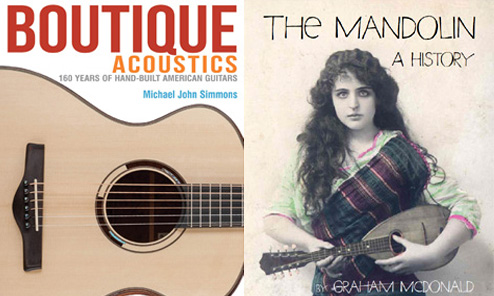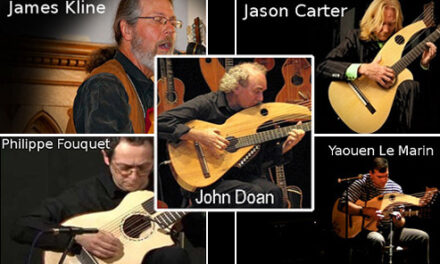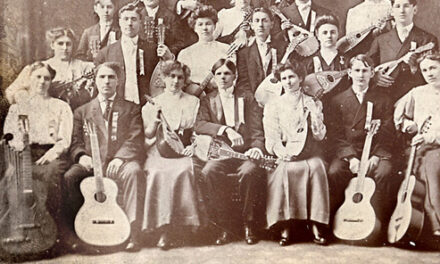Faithful readers are familiar with my occasional “book reports,” which usually turn out to be rants, as so many guitar books invariably screw up anything they try to include about harp guitars. So it’s nice to have something nice to say for once!
Harp guitars and harp mandolins each make a sizable appearance in two recent new books, one recently published, the other dependent on pre-orders from “viewers like you” (see below).

The one you can buy right now (and quite affordably) is Boutique Acoustics by Michael John Simmons. Michael should need no introduction, having co-founded the Fretboard Journal (but no longer affiliated) and being a longtime contributor to my harp guitar (and other plucked strings) research.
His latest book, subtitled “180 Years of Handbuilt American Guitars,” tells the story of the development of the handcrafted American steel-string guitar – with the twist being that it’s the first cohesive journey taking us all the way from C. F. Martin through Michi Matsuda. So there’s plenty of 100+-year-old background for modern guitar aficionados and loads of recent history for those of us who haven’t kept up! He also nicely puts the flat-top in context with all the other competing guitar forms along the way.
Growing up in the Chicago suburbs I was largely unaware of all the developments and activity that Michael reveals here of the 1960s to present period. Unwittingly sheltered, I knew of Mossman (my friend still has his) and Bozo (via Leo Kottke), but that’s about it (so was sad not to see Bozo in the book). There are plenty of names I’ve of course come across since (Gurian, Gallagher, etc.), but until now I didn’t necessarily understand their place in guitar history (as presented by the author).
It’s pretty cool seeing all these folks – with most of us counting one or more of them as friends – in the context of a well-researched history book. I just wish there were more! Some luthiers get a lot of attention, some get seemingly short shrift, but that’s inevitable with such projects.
It comes nicely illustrated with plenty of instrument examples, though I didn’t love the photo layout, which seems a bit arbitrary or misplaced. Speaking of photos, it’s a Tony Bacon production, so once again we see his old Chinery Collection pictures. I have to say I’m getting pretty tired of seeing that same short-scale Knutsen harp guitar in book after book (and frankly, Michael’s modern publication deserved new photos). Yes, Michael devotes some nice space to the importance of the historical American harp guitar. Though he refers to it as “odd” he knows that it was never a novelty and treats the subject seriously. There’s also a discussion of the early 12-string, which repeats much from my “The Birth of the American 12-string Guitar” article (which Michael himself was a contributor to). While the specific statements, theories and conclusions about harp guitars remain Michael’s own, much came out of a planned phone interview we did a year ago. Though Michael (or his editor) didn’t offer me a chance to review the text, there are happily no typical errors like all the other guitar books I’ve ranted about in my blogs (and hardly anything worth mentioning, so I won’t). I can only assume he did a similarly conscientious job on the restof the subject matter. I definitely recommend everyone pick up a copy.

Calling all mandolin fans! You have just two weeks left to help make a wonderful new book The Mandolin: a History a reality via the author’s Kickstarter project. There have been just a couple (and essential) books on the classical mandolin, along with nice theses by Ruppa and Hambly, but the huge variety of historical-to-modern instruments of all musical genres have never been the subject of such a generous study. And few mandolin buffs know as wide a range of information as Aussie mandolin builder and historian Graham McDonald. Fully illustrated in color and 400+ pages long, this much-anticipated book project has been a labor of love for Graham for several years (and those of us who have supported him along the way), as he has skipped around the globe (on his own dime) gathering precious information and photographs.
There is a ton of new eye candy – I’m surprised by how many instruments (or brands or makers) I’d never seen before. There are at least 15 photos of my mandolins alone, and I didn’t even know I had that many. Considering that Graham took the majority of photos himself in less-than-ideal “field conditions,” the quality is excellent and consistent throughout.
Among many other rarities and more obscure topics, he’s even included a surprisingly thorough section on harp mandolins (with no lobbying from me). When asked to review this harp-mando chapter and several other topics I had some small expertise in, I found little room for improvement, as Graham’s a very thorough researcher, a fine writer and clearly a great reader (showing a familiarity and a very good grasp of the research of others). And yet all this is distilled for the layperson.
I have no financial stake in this venture (and have myself splurged on the hardbound edition), but I really want this thing to succeed – we need this book! So please sign up at any level you possibly can. You can view two sample chapters and the extensive Table of Contents on the Kickstarter page. Additionally, serious scholars can contact me privately about the 12-page final chapter of acknowledgments, footnotes and sources if necessary.
Nice job, gentlemen!





